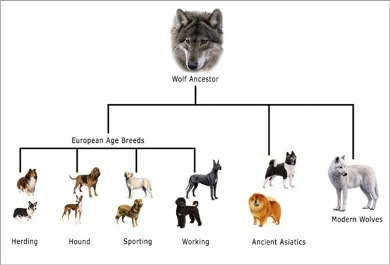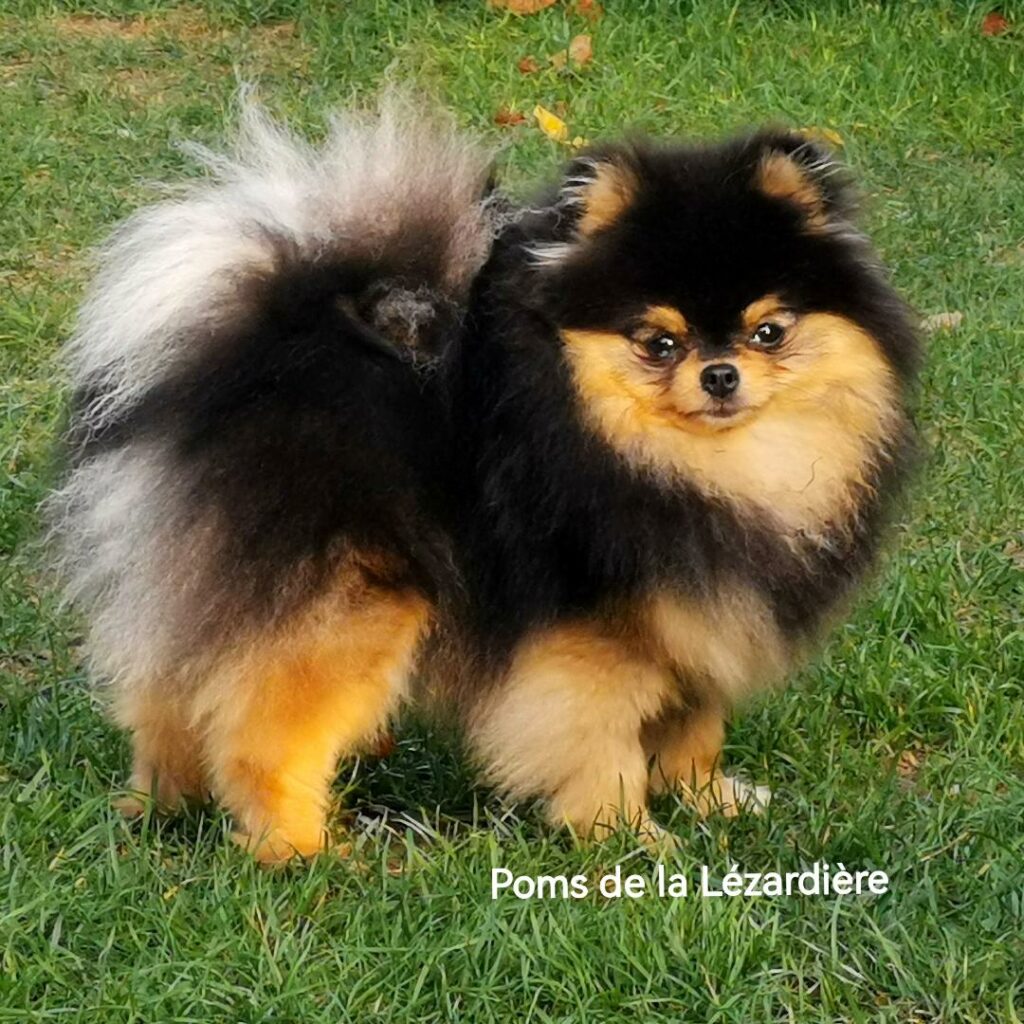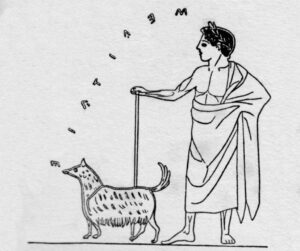From the ancestors of the Pomeranian Spitz to the German Spitz
A brief history
A direct descendant of the bog dog, it was the first breed to be domesticated in the Stone Age.
Several thousand years ago, the ancestors of the Pomeranian were medium to large Spitz dogs found in the Arctic region. In Iceland, people used them as sled dogs, and they were also sheepdogs and hunting dogs in the far north. They were used by the Scandinavian tribes to hunt elk.
Over the following centuries, Spitzes developed alongside humans while adapting to different needs in different regions.
History tells us that they weighed between 30 and 40 pounds (14 to 18 kg) and were mostly light in colour. Because of the hard physical work they did, they had a lot of muscle and were very strong.
They coped with sub-freezing temperatures because of their thick double coats (today’s Spitz breeds still have these coats). Although they work in packs and with people, they are still considered to be outside dogs.
The great ancestors of the Pomeranians had a similar look and size to the Keeshond. The Keeshond, Samoyed, Pomeranian and other Spitz breeds are all descended from these same dogs. Spitzes being lupoids (l’apparence rappelle celle d’un loup), on lui a donné le nom de “chien-loup”, qui est un diminutif du “loulou” de Poméranie.
Some migrated to southern Europe, specifically to Germany.
The classification of the Pomeranian as a German Spitz in the FCI countries is interesting. As various offshoots began to develop, Pomerania was reduced to a smaller size in a specific European region that used to be called “Pomerania” (this region is now near the Baltic Sea and covers parts of modern Germany and Poland).
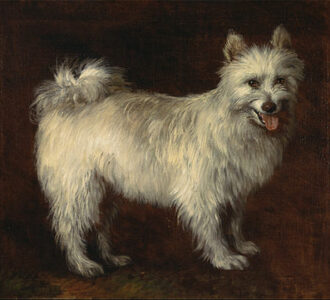
Spitz by Thomas Gainsborough around 1765

Pomeranian Windsor Marco
Marco was a German Spitz and was recorded as being named after Marco Polo, a well-known Italian traveller and merchant. Marco was born in 1888 and weighed 12 lbs. His coat was dark red sable but his hind hairs and tail were almost white.

Queen Victoria in a car with her Spitz, Tiri. Photograph taken in 1899 by Smith Archive.
In the 18th century, there was a large population of medium to large white Spitzes with a well established character. They were used as guardians.
The first reference to these dogs dates from 1764 and is attributed to the Scottish journalist James Boswell.
In the 19th century, the nobility began to take an interest in the breed and it was at the very end of the 19th and beginning of the 20th century that the Pomeranian became known, and today is known as the German Spitz.
The creation of the Dwarf Spitz as we know it today is attributed to Queen Victoria(1819-1901).
Queen Victoria was the granddaughter of Queen Charlotte, and she obviously inherited her grandmother’s passion for Pomeranians. She was widely recognised as the most famous person to own and exhibit Pomeranians in her lifetime.
Over the years, it has imported many Pomeranians from different parts of Europe. The dogs had different coloured coats and his kennel in Windsor housed over 30 Pomeranians.
While Queen Victoria was on holiday in Florence in 1888, she purchased a basic stock of Italian Spitz dogs also known as Volpino Italiano or Florentine Spitz.
When reading about the Queen and her passion for Pomeranians, you must understand that the dogs she loved at the time are not classified as Pomeranians today by the English Kennel Club.
Many improvements have been made to the Pomeranian breed type since the time of Queen Victoria and the Pomeranian is now part of the toy group in non-FCI countries.
The type of dog bred and loved by Queen Victoria is now called the German Spitz and is even presented in a different group in non-FCI countries.
Many celebrities have fallen for her beautiful head, such as Marie-Antoinette of Austria, Catherine II of Russia, Michelangelo, Wolfgang Amadeus Mozart, Emile Zola, Princess Ludovica of Bavaria, Empress Eugenie, and Josephine de Beauharnais.
Mozart dedicated one of his finished arias to his pet Pomeranian, Pimperl.
Frédéric Chopin, inspired by his friend’s pet pomeranian chasing his tail, wrote the song “The Little Dog Waltz”.
When Michelangelo was painting the Sistine Chapel, his Pom was sitting below on a satin pillow watching the action.
In France, the Pomeranian is not considered a separate breed but a variety of the German Spitz.
The German Spitz was definitively recognised by the ICF on1 January 1957.
Some countries, such as the USA (American Kennel Club) and England (The Kennel Club), which are not members of the FCI, distinguish between two separate breeds: the German Toy Spitz and the Pomeranian.

Princess Mary of England and her spitz

Loulou de Poméranie in the edition of
1911 ofEncyclopædia Britannica.
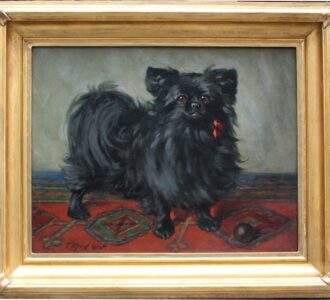
Painting of Thomas Alfred West
in 1930
Germany: German Spitz, not Pomerania
The name Pomeranian was only accepted by the Germans in 1974, who used the generic name German Spitz for themselves and claimed that this “German Spitz” was a German national breed.
This German Spitz was a healthy, robust and strong dog. It was a large working dog, often found in the Arctic regions of northern Europe. Its original name was Wolfspitz, a term referring to its small erect ears.
Origin and name Pomerania
The Spitz breeds are a family of dogs that lived in parts of Europe and Asia. Spitz dogs have erect ears, tails that curl over their backs and a thick double coat.
The name “Spitz” was not used as a name for these breeds until the 15th century. However, the name “Chien-loup” has been used and it is thought that the French phase “lou-lou” is derived from this name. Historians can find no record of spitz dogs before George III came to the throne in England.
In Germany, various older regional names for these Spitz dogs are translated into English and become the Wolf Spitz, the Lion Spitz, the Bear Spitz and the Great (aka Gross) Spitz.
The smallest dogs included the Fox Spitz and, a little later, the Mannheimer Zwerg-Spitze. In 1886 the Pomeranian breed was known as German Toy Pomeranians or Mannheimer Zwergspitze.
Where do Pomeranians come from?
The breed has evolved in a number of parts of Europe and has been given various names, several types having no connection with Pomerania.
In France, Lulu, Chien de Pomeranie or Lou Lou.
The Wolfshond was in Holland, but in the 1780s the name was changed to Keeshond.
Italy had many names for this dog, including the: Italian Spitz, Florentine Spitz, Cane de Quirinale, Lupino and Volpino. The Italian variety was usually bright orange or yellow.
The Swedish naturalist, Carl Linnaeus (1707-1778) spent much time classifying the dogs of his time. He mentions the Canis Pomeranus and provided ample evidence to support his theory that these dogs were well known in Central and Northern Europe.
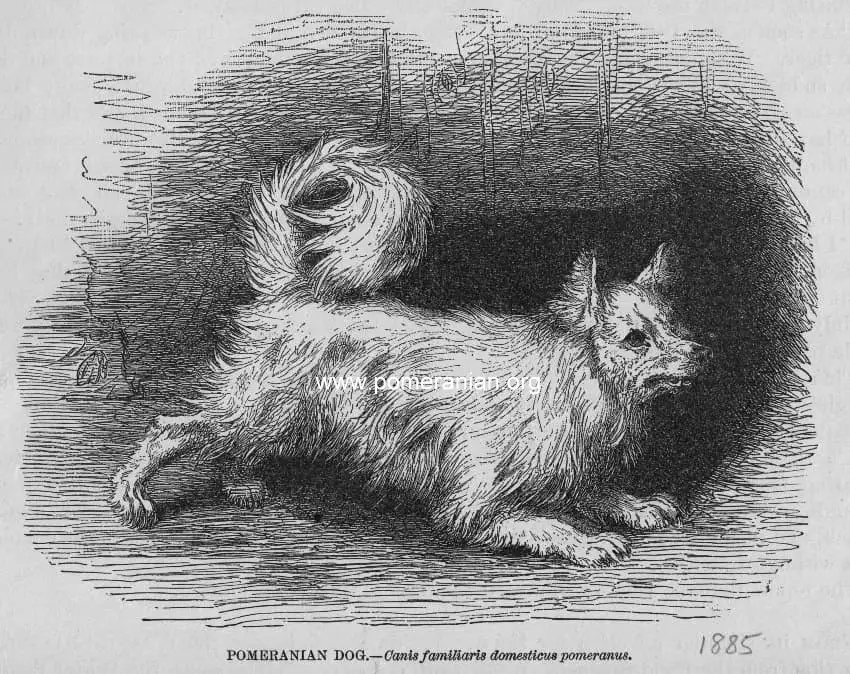
Pomeranie dog 1885
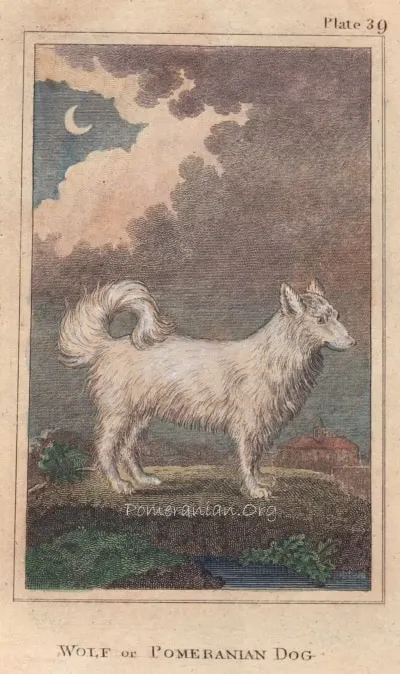
Wolf or Pomeranian dog
In England: Pomeranian Dog
Pomeranians developed as a breed by English amateurs
The Pom dog was developed as a breed and became known as the Pomeranian in England. It was not until the 18th century that the Pomeranian (then known as the Wolf Dog) became firmly established in England, as the breed attracted the interest of members of the English monarchy.
In 1761, when she married King George III, Queen Charlotte of the Duchy of Mecklenburg, a German territory neighbouring Pomerania, was just 17 years old and brought her pet dogs to England. Queen Charlotte’s dogs were what was then known as “wolfhounds” and were mainly white in colour.
The King’s son (King George IV) continued this royal tradition, and examples of this can be seen in paintings by Gainsborough and Stubbs.
Queen Victoria, granddaughter of Queen Charlotte, inherited her grandmother’s passion for Pomeranians.
We know that the Pomeranian is named after the territory in Germany from where Queen Charlotte imported her Pomeranians; Pomerania. Queen Charlotte at the time called the breed Pommeranian.
English Pomeranians were generally kept as pets and much information about these dogs comes from various paintings.
Written by William Taplin and published in London in 1803, ‘The Sportsman’s Cabinet’ deals with race in detail:
“POMERANIAN; or, WOLF-DOG.
The dog so called in this country is only a little over eighteen or twenty inches in height, and is distinguished by its long, thick, and rather straight coat, forming a most formidable ruff around the neck, but short and smooth on the head and ears; they are for the most part of a pale yellow or cream colour, and lighter on the under parts.
Some are white, some black, and some but very rarely spotted; the head broad towards the neck, and tapering to the muzzle; ears short, pointed, and erect; nose and eyes chiefly black; the tail large and bushy and invariably curled in a ring over the back. Examples of smooth or short-haired hairs are very rare; in England, it is morefamiliarly known as the fox-dog, and this may originally have arisen from the fact that he has much affinity with that animal around the head; but, by those who in their writings describe him as a native of Pomerania, he passes under the appellation of Pomeranian dog.”

Start Toy Pomeranian or Zwerg Spitz

Pomeranians Mesdames Kennel Club Show Angleterre 1896
Pomeranians made an impact in England after 1870
In 1859, Newcastle hosted the first ever English dog show and in 1861 another was held at Belle Vue Zoo in Manchester.
The English Kennel Club has registered the breed as Pomeranian
The Pomeranian Club was formed by nine members in 1891. This very first Pomeranian club was launched on 11 February 1891 at the Agricultural Hall, Crufts Dog Show.
There was a growing interest on the part of breeders to reduce the size of the dogs they were breeding, but also to produce new colours.
Whites and blacks were no longer at the forefront of breeding programmes and the show ring. Now there were other colours such as orange, sable, blue and chocolate.
During this period, shows offered classes for small, medium and large dogs and it took the English Pomeranian Club much longer to agree on an appropriate weight range for these incredible dogs.
The original standard of the Pomeranian breed is dated 1898.
1909 saw the development of a revised and much improved breed standard. A meeting was held at the Pet Dog Show with representatives of all Pomeranian Club contributors.
The reports of this meeting indicate that the 1909 Pomeranian Standard harmoniously embodied the views of all Pom clubs.
Ces clubs comprenaient le Pomeranian Club, le North of England Pomeranian Club, le East Lancashire Pomeranian Club et le Midland Pomeranian Club.
reference : pomeranian.org – Denise Leo, pomeranian breed expert, of Dochlaggie fame. Breeder and exhibitor of Best in Show Supreme, Grand Champion and Champions since 1975.
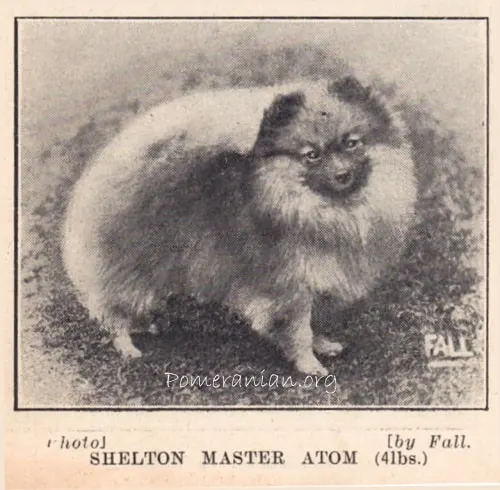
Pomeranian Shelton Master Atom
In the United States: Pomeranian dog
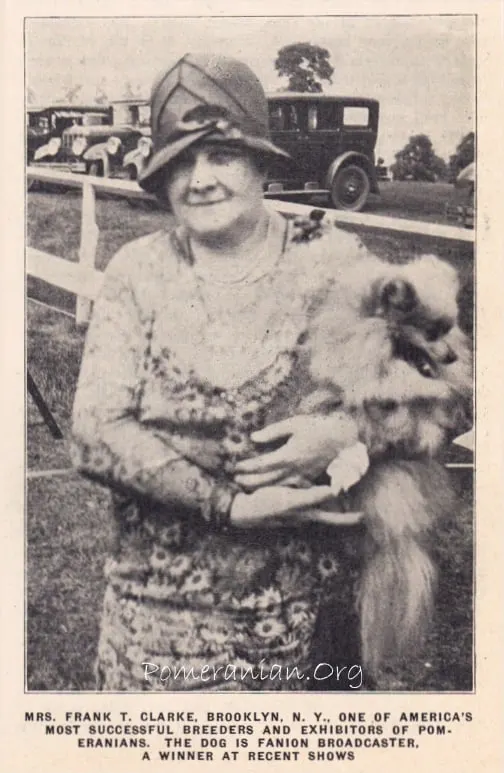
Mme Frank T. Clarke and Pomeranian Fanion Broadcaster
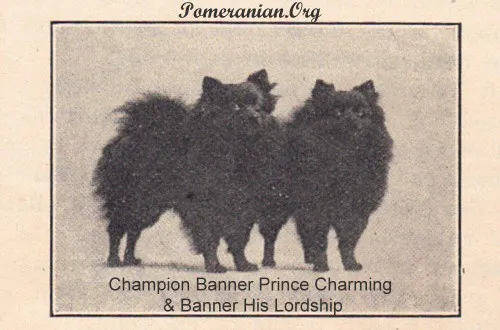
Champion Banner Prince Charming and Banner Sa Seigneurie
American Pomeranians originate from imported Poms, mainly from England. In the late 1880s, Pomeranians began to appear at various shows in the United States of America, where in 1900 the breed was officially recognised by the country’s Kennel Club.
Prior to this official sanction, the breed had to participate in the miscellaneous class. Not having a winning class meant that championship titles were not available during this period for the breed. The first known Pomeranian to be shown in America was Sheffield Lad, in New York in 1892.
In 1896, Pomeranians Prince Bismarck was placed 2nd and Wolfgang 3rd in the Miscellaneous class. Kansas City in 1898, saw the Pomeranian Clayton Chieftain win the Miscellaneous category.
In 1899, interest in the breed increased and large numbers of quality Pomeranians arrived from England.
White, blue and brown were the most popular colours. Around 1900, the American Kennel Club recognised the breed and approved admission to the stud book.
The New York Show of 1900 was the first to hold a winning class for Pomeranians. A brown dog, Nubian Rebel owned by Mrs Frank Smyth won this first prize. Nubian Rebel later became a champion.
In 1901, the New York Show was judged by MRF Mayhew and Hatcham Nip was ranked first. Hatcham Nip later became the first international champion of the breed. During this period, Mrs RF Mayhew and Mrs George Thomas were the main exhibitors in Pomerania.
The Pomeranians were presented in the United States in the Divers class as early as 1892. Regular classification was not provided until 1900 in New York. In 1900, the American Kennel Club recognised Pomerania and the American Pomeranian Club (APC) was formed. In 1909, APC was accepted as a member club of the AKC and became the designated parent club for the breed.
The APC organised its first specialist exhibition in 1911, with 262 Pomeranians taking part. The first Best of Breed winner was Champion Bannière Prince Charmant, owned by Mrs Frank Smyth of Swiss Mountain Kennels.
The second Pomeranian show organised by the American Pomeranian Club in 1912 took place in New York. The 185 Poms entry was judged by Charles G. Hopton. Best of Breed at this show was the English import, Champion Offley Kew Marco.
reference : pomeranian.org – Denise Leo, pomeranian breed expert, of Dochlaggie fame. Breeder and exhibitor of Best in Show Supreme, Grand Champion and Champions since 1975.
In Asia
The first domestic dog is called the “bog dog” on Canis familiaris palustris (Stone Age period 6000 years BC) and would therefore be the oldest breed in Europe. According to archaeological findings, preserved in peat, the Canis familiaris palustris resembled today’s large spitz.
These dogs are certainly the ancestors of all European and Asian spitzes, including the Japanese spitz, the Italian spitz and related breeds such as the Finnish spitz, the Samoyed, the Chow-chow and the Husky. It is likely that all these breeds are cousins.
The Japanese Spitz is a relatively new breed that was developed as a companion dog during the last century.
The origins of the Japanese Spitz breed can be traced back to around 500 AD when Spitz-type dogs, which were undoubtedly prized by their owners and breeders as companion dogs for their families, found their way to Asia and of course to Japan.
The first serious and continuous effort to develop the Japanese Spitz breed seems to have started in Japan in the 1920s and 1930s. They started with a number of different Spitz breeds and there is some debate as to the exact percentage and even the breeds used, but the American Eskimo dog, the White Russian Spitz and the German Spitz are generally accepted as adding to the genetic make-up of the Japanese Spitz breed that we have today. These early Japanese Spitz breeders crossed these breeds in an effort to improve the breed and their efforts seem to have worked as the Japanese Spitz has very few health problems today compared to most other purebred breeds and to other dogs in general. One could say that the Japanese Spitz is an early and successful designer dog breed that emphasized health and temperament.
Japanese Spitz breeders have managed to retain the genetic and temperamental characteristics of the breed without too much dilution. and the Japanese Kennel Club recognised the breed in 1954 and developed the standard which has been adapted for use around the world today.
The American Kennel Club, AKC, does not recognise the breed today because of the similarities between the Japanese Spitz and the developed American breed, the American Eskimo Dog, but the United Kennel Club in the United States recognises the Japanese Spitz in its northern breeds.
reference : japanesespitzhq.com
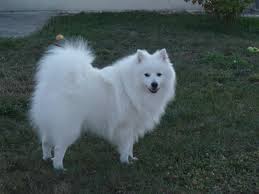

“I believe that my charity for animals is made up of the fact that they cannot speak, explain their needs, indicate their ills”, Émile Zola in “Le Figaro” of 24 March 1896. Rue des Archives/Mondadori Portfolio/Rue des Arch
“The Little Dog Waltz, Chopin
To wit: When various breeds of dogs were genetically tested, one discovery was that many breeds of Spitz dogs belonged directly to a group considered to be the closest relatives of wolves and are assumed to be the oldest known type of dog.
